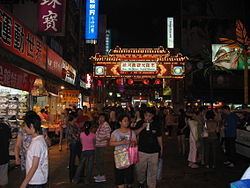Country Taiwan Area rank Ranked 9th of 12 Area 9.288 km² | Region Eastern Taipei Postal code 105 | |
 | ||
Divisions List
33 villages
760 neighborhoods Website About Songshan District Points of interest Raohe Street Night Mar, Ciyou Temple, Fujin Street, Taipei Cultural Center, Taipei Puppetry Museum | ||
Songshan District is a district of Taipei, Taiwan. The name of the district is historically spelled Sungshan. The Songshan Airport and the Taipei Arena are located here.
Contents
- Map of Songshan District Taipei City Taiwan 105
- History
- Administrative divisions
- Government institutions
- Institutions
- Economy
- Education
- Tourist attractions
- Roads
- Metro
- Railways
- References
Map of Songshan District, Taipei City, Taiwan 105
History
Songshan was originally named Malysyakkaw, a lowland Ketagalan word meaning "Where the river twists". Its written form (Chinese: 麻里折口; Pe̍h-ōe-jī: Bâ-lí-chek-kháu) was abbreviated (錫口; Sek-kháu) in 1815 during Qing rule.
During Japanese rule (1895-1945) the area served as a prime tea-growing area in northern Taiwan. In 1920 the area's settlements were established as Matsuyama Village (Japanese: 松山庄), Shichisei District, Taihoku Prefecture. The village, named after Matsuyama City in Japan, was incorporated into Taihoku City (modern-day Taipei) in 1938.
At the outset of one-party rule by the Kuomintang (1945-1990) the Mandarin Chinese reading of the kanji characters 松山 (i.e. Sung-shan) was adopted as the name of the district which in 1946 officially comprised 26 municipal villages (里). In 1949 the area's tea estates gave way to military housing for lower-income Kuomintang refugee families. The bodies of many residents and political victims from Taiwan's martial law period are buried in hillside cemeteries that now overlook the Taipei 101 shopping district. By 1980 Songshan was the most populous area of the city.
In 1990, as Taiwan began its era of modern multiparty democracy, the southern half of Songshan District became Xinyi District while the northern half retained its original name. The boundary of this smaller Songshan District was altered in May 1994 when the Keelung River was artificially moved slightly to the south.
Administrative divisions
Songshan is divided into four regions (地區), or secondary district (次分區), which in turn are divided into 34 municipal villages. They following placenames are romanized in Hanyu Pinyin:
The airport is located in Dongshe Region, mostly in Jinzhong Village.
Government institutions
Institutions
Economy
Mandarin Airlines, Daily Air and Far Eastern Air Transport have their headquarters in Songshan.
China Airlines formerly had its headquarters in the location of its current Taipei Branch Office on Nanjing E. Rd. Its headquarters moved to a new location, CAL Park at Taoyuan International Airport. After the headquarters move, China Airlines will allow tenants to rent space in its former headquarters. As a result of the headquarters move, China Airlines will develop part of the training center at Taipei Songshan Airport into a business aviation center.
Education
In addition, there are two regular high schools (Xisong and Zhonglun), six middle schools, eight elementary schools, and 23 kindergartens in Songshan
Tourist attractions
Roads
Fuxing North Road (復興北路) runs along the western boundary of the district. The other major north-south road is Dunhua Road (敦化北路). Several major east-west arteries include Minquan East Road (民權東路), Sec. 3-5; Minsheng East Road (民生東路), Sec. 3-5; Nanjing East Road (南京東路), Sec. 3-5; and Bade Road (八德路), Sec. 2-4.
The southern border is outlined by the Civic Blvd (市民大道). Meanwhile, National Highway No. 1 borders the northern part of the district.
Metro
The metro access is provided by the Neihu Line above Fuxing Road and the Songshan Line provides east-west access underneath Nanjing East Road.
